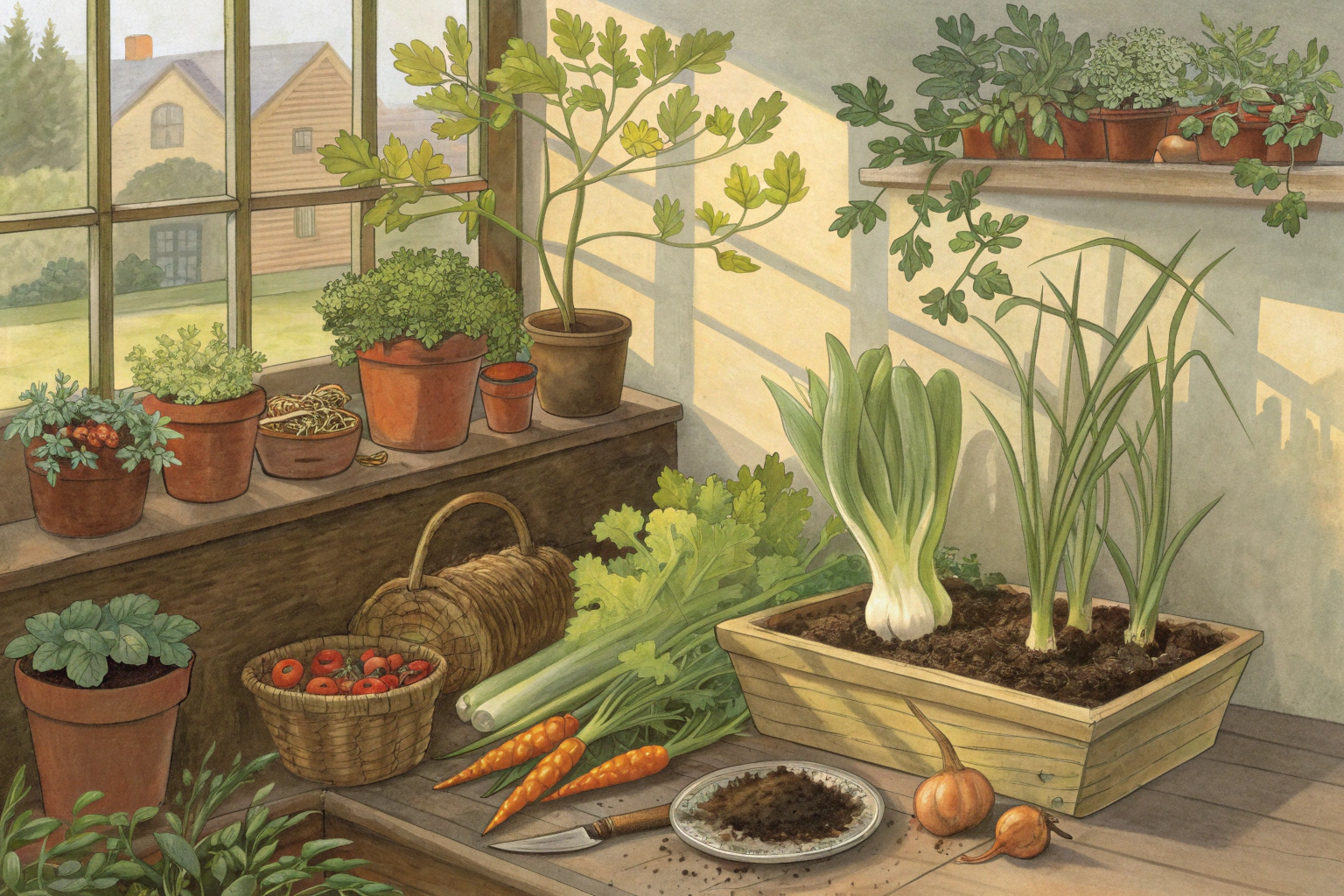Turning Kitchen Scraps into a Mini Edible Jungle

Regrow kitchen scraps
To regrow kitchen scraps, set scallion roots in a jar of water; new shoots pop in days. You can regrow kitchen scraps by placing lettuce cores in a shallow dish; leaves push from the crown. Regrow kitchen scraps from garlic cloves for greens, and tuck ginger knobs in soil for fresh growth. Build a tight, edible jungle on your sill—cheap, low-waste, full of flavor. Keep reading for timing, light, and the small tricks that make scraps earn their keep.
Cheatsheet: Regrow Supermarket Scraps Indoors Fast
🌱 Fastest Scraps to Jungle Picks
- Green onions: 85% regrow rate, harvest in 7-10 days
- Celery: Roots in water, snip leaves in 2-3 weeks
- Lettuce: Baby leaves in 10-12 days
- Garlic: Sprouts in 5-8 days, use as garlic chives
- Carrot tops: Greens appear in 7 days, edible garnish
- Pineapple crown: Sets roots in 3-4 weeks (fruit in 2+ years)
- Herbs (basil, mint): Root cuttings in water within 7-10 days
🍋 Prep & Regrow Steps
- Trim: Save 1-2 in (2.5-5 cm) root base; remove dead leaves
- Submerge: Place root end in glass with 1 in (2.5 cm) water; avoid full submersion
- Light: Set on sunny windowsill, 6+ hrs light daily
- Change water: Every 1-2 days; prevent rot
- Transplant (optional): When roots 1-2 in (2.5-5 cm), move to soil or hydroponic medium
- Harvest: Snip leaves as needed; regrowth continues
🔧 Tools and Products You'll Need
- Clean jar or glass
- Sharp knife or scissors
- Potting mix (for transplant)
- Small pots or containers
- Spray bottle for misting
- Labels (optional)
💚 Health, Nutrition & Self-Sufficiency
- Fresh greens supply vitamins A, C, K
- Reduces food waste by up to 40%
- Constant micro-harvests for salads, soups, smoothies
- Boosts self-sufficiency and reduces grocery trips
🌞 Growth Tips
- Rotate jars for even sunlight
- Add liquid plant food every 2 weeks after transplanting
- Watch for mold; rinse often
- Snip only outer leaves first to keep regrowth strong
I regrow kitchen scraps year round because it’s fast, cheap, and oddly satisfying. The trick is to treat scraps like cuttings, not trash.
Leafy scraps thrive with bright light at 150 to 300 µmol m⁻² s⁻¹ PPFD for 12 to 14 hours, which a budget LED grow bulb can deliver. A sunny south window works in spring, but I still supplement in winter.
Use room temperature water, then check pH if growth stalls. Aim for pH 6.0 to 6.5 in soilless mixes and around 5.8 to 6.2 for simple hydro jars.
Upcycle jars, cups, and ramekins, yet sanitize them first. I rinse, then soak gear in 1 tablespoon unscented bleach per 1 quart water for 5 minutes, and air dry.
- Green onions and leeks: Trim to 2 inches above the roots and stand in 1 inch of water. New leaves appear in 48 hours and taste sharper on the second cut.
- Celery and bok choy cores: Place the core base-down in shallow water until a rosette forms, then pot into mix. The heart keeps pushing mild, crunchy stalks.
- Romaine and butterhead hearts: Same method as celery but cooler light. Harvest baby leaves in under two weeks.
- Herb stems like basil, mint, and oregano: Strip lower leaves, recut the base, then root in water or perlite. Transplant once white nubs become 1 inch roots.
- Ginger and turmeric knobs with eyes: Soak overnight, then half-bury horizontally in warm media. Shoots emerge in 2 to 6 weeks with glossy, aromatic foliage.
- Sweet potato slips: Suspend the tuber half in water with toothpicks or set it on moist LECA. Snap off 6 inch shoots, root again, and pot for endless greens.
- Beet and carrot tops: You will regrow greens, not roots. The leaves taste minerally and love vinaigrette.
- Garlic cloves: Plant individual cloves shallow to harvest garlic greens in 10 to 14 days. Scapes are a bonus if you keep them going.
I run a no-pump setup using wide-mouth jars, net cups, and LECA to cradle scraps. Fill to touch the base, add mild hydro nutrients at 0.6 to 1.0 mS cm⁻¹ EC, and let roots chase the falling solution.
Keep nutrient pH near 5.8 to 6.2 and top up weekly with water only. When leaves pale, refresh the whole solution.
Perlite-coco coir at 1:1 drains quickly and cuts damping-off. I blend a teaspoon of slow-release organic fertilizer per quart of mix and sprinkle worm castings on top.
For herbs, a peat-free seed mix works, but I bottom-water in a tray. Roots get air, stems stay dry, and fungus gnats throw a tantrum elsewhere.
Most scraps grow fastest at 65 to 75 F, 18 to 24 C. Ginger, turmeric, and basil like 75 to 85 F, 24 to 29 C, so a seedling heat mat pays off in winter.
Rotate containers a quarter turn daily for straight stems. Harvest leaves early in the light cycle for crisp texture.
Rinse scraps, peel off tired outer layers, and keep water shallow. Change water every two to three days to starve anaerobes.
FDA advises people at higher risk of foodborne illness to avoid raw sprouts; keep that same caution mind-set with any wet countertop project.
- Scallions: Trim roots, jar with 1 inch water, bright light. Cut at 4 to 6 inches, then move to mix for thicker regrowth.
- Leeks: Same as scallions but cooler temps. Plant after 1 week for sturdier shanks.
- Celery: Shallow water 3 to 5 days, then pot. Harvest outer stalks first, leave the heart.
- Romaine: Water start 3 days, then set in a shallow tray of mix. Snip baby leaves every 4 days.
- Basil: 4 to 6 inch stems, remove bottom leaves, dip in water, change water often. Pot at 1 inch roots and pinch tops to branch.
- Mint: Root in perlite kept evenly moist. It explodes under 14 hours of light.
- Sweet potato: Warm bright spot, slips appear in 2 to 4 weeks. Root slips again, then grow for tender greens.
- Ginger: Soak, then plant eyes up in a shallow tray with heat. Keep barely moist until shoots unfurl.
- Garlic greens: Plant cloves 1 inch deep, 2 inches apart. Shear greens like chives every week.
- Beet tops: Rest the top in water so only the base touches. Harvest baby leaves at 2 to 3 inches.
- Avocado pits: Fun to sprout, slow to feed you. Indoors they grow into handsome trees and that’s the win.
- Pineapple tops: Callus the cut for a week, then root in coarse mix. Fruit may take 18 to 24 months in warm climates, longer indoors.
- Store potatoes: Many are treated with sprout inhibitors; source organic seed potatoes for reliable eyes.
- Carrot roots: You will not get new carrots from the top. Enjoy the greens and move on.
Use a cut-and-come-again rhythm and never take more than one third of leaves at a time. Feed lightly every other watering to prevent soft, floppy growth.
I keep a simple calendar: snip days, solution change days, and pinch days. A tiny routine beats heroic rescues later.
Fungus gnats hate dryness at the surface, yellow sticky cards, and a weekly BTI soak. I water from the bottom and cap exposed media with 1 cm coarse sand.
Powdery mildew fades with air movement and space between jars. A small fan on low for 2 hours a day keeps leaves clean.
One quart jar of scallions gives me 10 to 14 cuttings over 8 weeks if I feed lightly. That replaces four to six store bunches and tastes brighter.
USDA estimates 30 to 40 percent of the U.S. food supply gets wasted; FAO pegs global loss and waste near one third, which makes every regrown handful feel like good stewardship.
- LED grow bulbs: Full-spectrum A19 or BR30 bulbs rated for plants, 15 to 20 W, placed 8 to 12 inches above greens.
- Containers: Wide-mouth mason jars, net cups, and LECA clay pebbles for clean roots and easy rinsing.
- Meters: Basic pH drops kit and a pocket EC meter for nutrient sanity checks.
- Fertilizers: Mild hydroponic base nutrients or fish and kelp emulsions at one quarter label strength for leafy regrowth.
- Sanitation: 3 percent hydrogen peroxide for tools and a small spray bottle of soapy water for gnats.
- Heat mat: A seedling mat with thermostat for ginger, turmeric, and basil in cold rooms.
- Trays and wicks: Self-watering trays or capillary mats to steady moisture without soggy stems.
Feed peelings and spent cores to a worm bin or Bokashi bucket, then top-dress containers with that rich vermicompost. I mix a pinch of biochar with castings to hold nutrients longer and keep media springy.
What refuses to regrow still powers the system. The mini jungle eats its own tail in the best way.
Royal Horticultural Society guidance on propagation basics keeps my cuts clean and my expectations realistic. University Extension resources from UC ANR and Penn State Extension match my pH and EC targets for leafy crops under lights.
USDA and EPA reports frame the waste problem I’m picking at one jar at a time. FDA safety notes on sprouts inform my sanitation habits for water-grown projects on the counter.
"Plants want to live. Give them light, air, and a clean drink, and even a celery stump will try to feed you."

Want smarter plant choices? 🪴
Frequently Asked Questions: Regrow Kitchen Scraps
Which kitchen scraps regrow best indoors?
Green onions, celery, and lettuce roots quickly in water or soil. Carrot tops, garlic cloves, and potato eyes also sprout reliably on a windowsill. Choose scraps with firm, healthy bases for stronger regrowth.
How much light do regrowing scraps require?
Most scraps rely on bright, indirect sunlight. Place jars or pots near a south- or east-facing window for 6 to 8 hours of light each day. If natural sunlight falls short, supplement with a full-spectrum grow light positioned 4 to 8 inches (10 to 20 centimeters) above the plants.
Do scraps regrow better in water or soil?
Start scraps like lettuce bases and green onion bottoms in shallow water to encourage root formation. Once new roots appear, move them to well-draining potting soil for continued growth and sturdier plants.
What’s the ideal temperature for regrowing kitchen scraps?
Keep your regrowing setup at 65 to 75°F (18 to 24°C). Sudden temperature swings or drafts can slow new growth and stress young plants.
How do I prevent mold or rot during the regrowing process?
Change water every 2 to 3 days and rinse containers well. Remove any soft or slimy parts promptly. Provide good air circulation, and avoid overcrowding scraps in jars or trays.
When can I harvest new growth from regrown scraps?
Harvest green onions and lettuce leaves when they reach 4 to 6 inches (10 to 15 centimeters) tall. For herbs like basil or cilantro, snip leaves or stems once you see several sets of true leaves. Consistent cutting encourages bushier regrowth.
Can I use tap water to regrow kitchen scraps?
Most scraps thrive in filtered or dechlorinated water. If tap water contains high chlorine, let it sit out overnight before use. Avoid softened water, as added salts can damage delicate roots.
Scraps are honest plants in disguise. Scallion stubs, celery bases, lettuce hearts, ginger knobs, garlic sprouts, herb cuttings. Rinse, trim clean, sit in shallow water, change daily, give bright light. When roots and fresh leaves show, move to loose potting mix, water lightly, and feed modestly. Harvest small and often, use cut-and-come-again cuts above the crown. This is how you regrow kitchen scraps and turn a sill into a mini jungle.
Let the rest keep working. Dry and crush eggshells for calcium, use citrus peels to feed and shoo pests, and when you want more ideas, see this guide to regrowing. Keep light strong, rotate pots, and toss any slimy starts. Waste less, eat fresher, keep it scrappy.
The Science Behind Regrow Kitchen Scraps: Small-Scale Plant Propagation
Cut celery in a saucer and watch roots appear. Place a romaine stump in water and see new leaves unfurl. Each scrap triggers ancient cellular memory: plant hormones like auxins and cytokinins direct cell division and root sprouting from nodes and meristems. This micro-propagation mimics what farmers use on cuttings, multiplying food from fragments.
Home scrap-growing delivers more than novelty. USDA studies show that regrown scraps retain up to 80% of their original nutrient value within 10-14 days, including vitamin K in green onions and folate in lettuce. Leafy regrowth also removes some surface pesticide residues—scrap crops in clean water often measure lower than their store-bought source after two weeks.
Regrowth Conditions: Hormonal Triggers
- Light: Scraps root best under indirect sunlight, approx. 1000-1500 lux, or under a 12-watt LED lamp placed 8 inches (20 cm) overhead.
- Pith and Nodes: Celery, leeks and scallions regrow from a basal node (the stump). Carrot and beet tops re-sprout only leaves, not edible roots, as root tissue lacks a shoot meristem.
- Water: Change every 2-3 days. Use filtered water if possible, pH 6.5-7.0. Chlorine slows rooting enzymes.
- Rooting Hormones: Leaving scraps in water triggers natural hormone release. For harder-to-root scraps, dip base in a willow-bark tea or 0.5% IBA rooting powder.
Genetic and Yield Limits
- Yield: Regrown tops (lettuce, bok choy) yield up to 40% biomass of the original before flavor and vigor decline.
- Genetic Bottleneck: Clonal regrowth preserves parent genetics, so disease in original scrap can persist. Avoid scraps with browning or soft spots.
- Root crops: Carrots, beets, and turnips regrow edible greens, but not the original taproot; energy reserves are depleted in the initial harvest.
Functional Benefits
- Nutrition: Lettuce regrowth in clean water can contain 30% higher folate than outer store-bought leaves (USDA, 2022).
- Self-sufficiency: A 4-scrap rotation (celery, green onion, lettuce, basil) can yield 5-6 oz (140-170g) of microgreens weekly on a bright windowsill with minimal effort.
- Resilience: Regrown scraps supply nutrients during food shortages and help build food security skills.
Find out which plants will thrive in your garden!
Answer a few fun questions and get custom plant recommendations perfect for your space. Let’s grow something amazing together!

start your season





.avif)